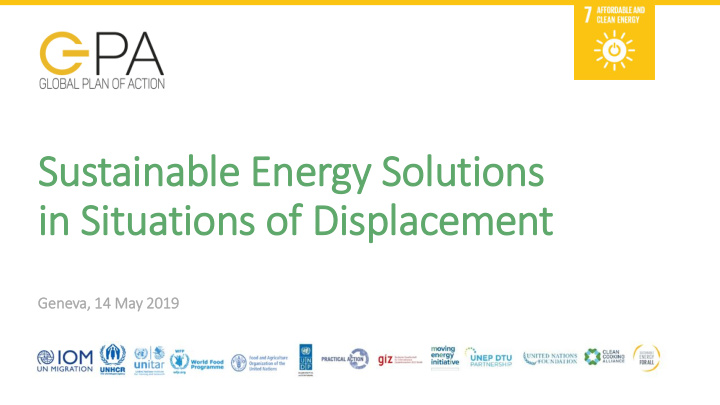



Su Sustainable En Energy gy Sol Solutions s in Situation ons o of Di Displace acement Ge Geneva, 14 14 May 2019 y 2019
Steeri ring G Group M Members Steered by: Supported by:
Agenda o Part I: Setting the Scene o Overview of Energy in Situations of Displacement and the GPA o Part II: Concrete Activities & Supporting Best Practices o Priority Activities from the GPA Framework within Five Thematic Working Areas o Best Practices from the Field and the Next Steps o Part III: Pathways for Collaboration
Par art I t I: Se Setti ting the Sc Scene
What i is the e e ener ergy s situation i in d displacem cement s settings?
Ener ergy S Situati tion i in D Displacem cemen ent S Setti tings High Forced Migration Rates Poor Energy Access • 68.5 million displaced population • 90% no electricity access • Over 25 million displaced by • 80% rely on solid fuels for natural disaster annually cooking New Political Impetus Existing Cost of Response • Rethinking the response for the • Over $1.2 billion spent on oil displaced: GCR, GCM, CRRF based fuels in 2017 (including around 800 Mio. fuel for • Environmental stress for hosts transportation) • UN to be carbon neutral
Relevance e of Ener ergy t to the H Humanitarian C Cluster ers Where Does Energy “Fit?” Answer: Everywhere The GPA seeks to accelerate and improve the incorporation of energy access across all humanitarian clusters & sector groups, where relevant
Key C Challen enges es Energy is not a Displaced people Energy in Limited expertise Limited and formal priority in are not included displacement and capacity to poorly shared humanitarian in national or settings is plan or data on assistance international underfunded implement humanitarian energy-access sustainable needs and agendas energy solutions solutions
What t is th the G e Glob obal P l Plan of of Acti ction?
Histor ory - From om I Idea eas t to Ac Action ons January 2018: Energy for 1 Displaced People Conference, Berlin February - June 2018: 2 Drafting the GPA Framework July 2018: Launch of the GPA 3 Framework and Support Structure, HLPF New York August - December 2018: 4 Developing the Work Plan Feb 2019: 2019 Key 5 Activities Published
What t is th the G e Glob obal P l Plan of of Acti ction? Vision of the GPA Every person affected by conflict and natural disaster has access to affordable, reliable, sustainable and modern energy services by 2030. Guiding Principles Non-Binding Framework Multi-Sectorial Bottom Up Holistic Collaborative
The G GPA Support rt S Structure Steering Gr g Grou oup, Coor oordination U Unit, W Wor orking Gr g Grou oups Steering Group: Overseeing and leading the process • 1 Providing advocacy and expertise (also in house) • Fundraising • Implementation • 5 2 Working Areas: Active forums for collective activities 1) Planning & Coordination; 2) Policy; 3) Innovative Finance; 4) Capacity Building; and 5) Data Steering Group Coordination Unit: + Providing day to day support to the Steering Group • Coordination and Working Groups Unit Coordinating activities from the Work Plan; • 3 4 Raising awareness • Developing of new initiatives and projects • Fundraising •
Par art t II: Con Concr crete Act Activiti ties & s & Su Supporti orting Be Best t Pract ctice ces s
Sele elected P Prio iorit ity A Activ ctivit itie ies f for or 2 2019 Working Area 1: Planning and Coordination o Humanitarian Energy Conference – July, Addis Ababa Working Area 2: Policy, Advocacy & Host Country Resilience o National-level dialogues to include displaced people in development plans and energy into national humanitarian commitments (e.g. GCR & GCM) Working Area 3: Innovative Finance o Creating a framework for sustainably powering humanitarian operations (e.g. by involving private sector, de-risking mechanisms & multi year financing solutions) Working Area 4: Technical Expertise, Capacity Building & Training Series of Webinars and set of standard curricula o Working Area 5: Data, Evidence, Monitoring & Reporting Building / Adaptation of an Energy Needs Assessment Tool, incl. common set of indicators o
Best P Practi tices ces: UNHC HCR Za Za’atar ari Solar S System, J , Jordan
Best P Practi tices ces: IOM OM Solar ar P Pumping P Program amme
Best P Practi tices ces: Moving En Energy Initiative
Worst P t Practi ctices ces: Solar S Str treet Li t Lighting
Par art t III: Pathways f s for or Col Collaboration
What t are P e Pos ossibil ilitie ities f for or a a Col olla laborativ ive A Approach? How can we support? - Advocacy - Bundling of projects from different agencies - Ensuring engagement with key stakeholders - Share data and best practices - Liaising with the private sector
Thank k yo you Aimee ee J Jenks ener ergy@unitar.or org Desk Officer, GPA Coordination bit.ly/En EnergyG yGPA Unit
Recommend
More recommend